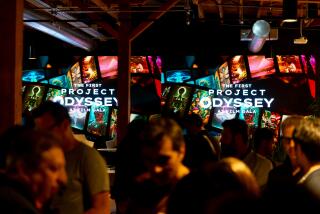Tech Oscars honor software, cameras
- Share via
A visual-effects tool used extensively in such movies as “Spider-Man,” “Ice Age,” “Hollow Man” and “The Perfect Storm” is among three Oscar honorees for scientific and technical achievements that were announced Monday by the Academy of Motion Picture Arts and Sciences.
Known as Maya, the software program is a 3-D animation, modeling and rendering production tool developed by Alias/Wavefront that is now widely used in Hollywood.
The program allows for the creation of computer-generated versions of everything from character models to sets and backdrops that are virtually indistinguishable from live-action film footage.
Oscars will also be awarded to Arnold & Richter Cine Technik and to Panavision Inc. for the two companies’ continuing advancement in camera systems that, the academy said, define the state-of-the-art in motion picture camera technology.
At the same time, the academy’s Board of Governors voted to award four plaques for scientific and engineering and six certificates for technical achievement.
The scientific and engineering awards went to Glenn Sanders and Howard Stark of Zaxcom for designing the portable Deva Digital Audio Disk Recorder, which is used in production and post-production recording applications; Mark Elendt, Paul Breslin, Greg Hermanovic and Kim Davidson for their continued development of the Prisms program, whose Houdini software package is used to simulate natural phenomena using particle effects and complex three-dimensional models; Leslie Gutierrez, Diane Kestner, James Merrill and David Niklewicz for the design and development of the Kodak Vision Primier Color Print Film, 2393, that produces a bold, colorful look on the theater screen; and Dedo Weigert for the concept, Chin Depu for the optical calculations and Franz Petters for the mechanical construction of the Dedolight 400D set light.
Certificates for technical achievement were announced for Dick Walsh for development of PDI/DreamWorks’ facial animation system; Thomas Driemeyer and the mathematicians, physicists and software engineers of Mental Images for their contributions to the Mental Ray rendering software for motion pictures; and Eric Daniels, George Katanics, Tasso Lappas and Chris Springfield for the development of Deep Canvas rendering software for animated movies.
Also to receive certificates are Jim Songer for his contributions to the technical development of video-assist in the motion picture industry; Pierre Chabert of Airstar for the introduction of balloons with internal light sources to provide set lighting; and Rawden Hayne and Robert W. Jeffs of Leelium Tubelite for their contributions to the development of internally lighted balloons that provide soft light that can cover a very large area.
The scientific and technical Academy Awards will be presented March 1 at a gala black-tie dinner at the Regent Beverly Wilshire Hotel in Beverly Hills.


